Football/Soccer Session (Difficult): Using the fullbacks in possession. (Start Time: 2018-10-06 09:30:00)
Profile Summary

| Name: | Noel Sritharan |
|---|---|
| City: | Middlesex |
| Country: | United Kingdom |
| Membership: | Adult Member |
| Sport: | Football/Soccer |
Description
Principles of play: Movement, Support, Penetration.Theme: Technical/ tactical: Using the full back in build up play from the back against a mid to high press to maintain possession and get the ball into midfield in free play and from throw ins, technical ability to receive under pressure.Social: Verbal and non-verbal cues/ triggersPsychological: Confidence to receive the ball and maintain possession under pressure.
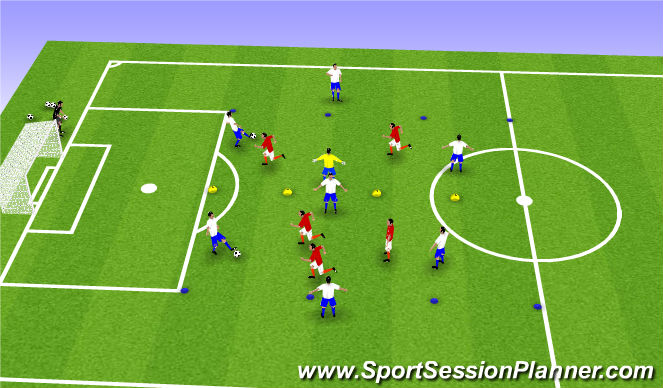
See the guidance at the top of this page to understand why you are not seeing interactive Football/Soccer images.

Lead in session (10 mins)
Rondos - 4v2 or 4v3, players can begin outside the playing area (20 by 32 yard rectangle) first few minutes until they are used to the set up, then look to get all players inside to replicate full pressure. If the defender gets a touch on the ball, the player at at fault (poor pass or a difficult pass to control which lead to a poor pass, therefore the player who passed) becomes the defender. If the same defender (s) have played in the middle for over a minute, change the defender. Which group of 4 can have the most passes in a row?
Progressions:- Reduce the space, play with 2 footballs or the red team must keep the ball for as long as possible.- make it 3v4 or 4v4 where possible.
Coaching points:
- Eyes up and pass selection; instep, inside or outside of foot, disguise on pass, ground pass or in the air (lofted with/ without curl, chipped, or driven)
- Decision making: first time pass or take additional touch(es), pass to nearest team mate, use disguise/ feints, penetrate through defenders.
- Movement to support at angles, provide width and depth for player on the ball, at least 2 options (triangle/ diamond).
PTO
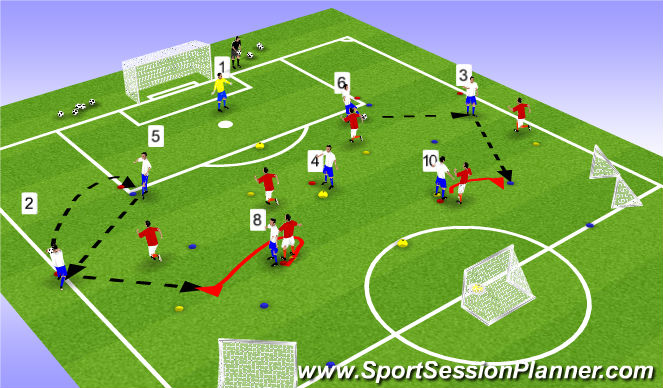
See the guidance at the top of this page to understand why you are not seeing interactive Football/Soccer images.

Split practise (15 mins)
Organisation: Team in possession (focus) playing 1-4-3-3 against a 1-4-4-2. On half a pitch (50 yards long by 40-50 yards wide) where team in possession have defence and midfield against attackers and 4 in midfield. The pitch is split into halves from the 18 yard box untilt he halfway line, with wide lanes to give a reference for the full backs of there area to receive in. Only the goalkeeper and Defensive midfielder are playing in both halves, each half has a centre back full back and centre midfielder against a striker, winger and centre midfielder. If numbers are limited, the holding midfielder can be removed or 2 central midfielders (from both teams) can be replaced with a mini goal/ target for the full back to aim to pass the ball into. The aim is for the midfielder to play the ball into a mini goal. The goalkeeper or coach will give the ball to the centre back and on their first touch, play is live as they look to give the ball to the fullback. The team in possession will have red space markers as reference points for their starting positions.
The first 2 or 3 repetition will be against passive defenders, then the defenders will have slightly withdrawn starting positions (yellow space markers) but with pressure once the ball is played (full back has the ball). After some success, progress into full pressure with the opponents having a slightly withdrawn start position. If the opponents win the ball they can go for goal. Practise restarts if the ball goes dead or if the white team lose the ball a second time.
Progressions:
- Allow the opponents to start where they like (not necessarily a mid press
block) how will the team in possession react?
- Alter the numbers where possible to create overload for the opposition. If the ball goes our for a throw to the white team, the play is restarted with a throw by the fullback.
Primary player: Full back (2 or 3)
Primary unit: Centre back (2,5 & 8 or 3,6 & 10)
Secondary unit: GK & defensive midfielder (4)
Opposition management: Can you win the ball and create a goalscoring opportunity.
Coaching position: Behind the goalkeeper to feed footballs in to him or the centre backs.
Trigger: When the Centre back or secondary unit takes a touch towards you, be on half turn at an angle to receive.
Second trigger: If the player on the ball is facing forward, look to support potential recipient at an angle where possible e.g. 5 to 8.
Coaching points:
Support, movement, create space:
- Full back to utilise width of lane at an angle (ideally 45 degrees).
- centre mid movement to lose marker and support full back and be able to play into mini goals.
- Centre backs and secondary unit to offer supporting angles through intelligent movement into space or to create space for full back.
Penetration: Look to exploit space behind opponents midfield 4 with accurate passing, good movement and supporting angles to get ball forward (mini goals).
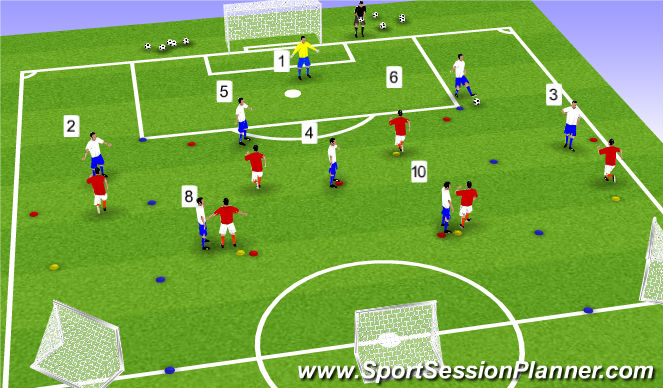
See the guidance at the top of this page to understand why you are not seeing interactive Football/Soccer images.

Learning Objectives

|
Technical Passing and receiving under pressure |

|
Tactical Making the pitch big and outnumbering opposition in areas of the pitch to build possession into the midfield. |

|
Physical Moving to receive, using different body parts, core strength to protect the ball and draw fouls. |

|
Psychological Confidence to throw, receive and pass the ball in difficult circumstances |

|
Social Eye contact, gestures to show where you want the ball, communicating with your team mtes/ |
Main practise (25 mins)
Organisation: Same as above but now the split is removed to a half pitch practise, still with wide lanes. If numbers are limited, the holding midfielder can be removed or a striker from the opposition and centre back can also be removed. The aim is for the midfielder to play the ball into a mini goal. The goalkeeper or coach will give the ball to the centre back and on their first touch, play is live as they look to give the ball to the feedback.
First part of phase: The first 2 or 3 repetition will be against passive defenders, then the defenders will have slightly withdrawn starting positions but with pressure once the ball is played (full back has the ball). After some success, progress into full pressure from the centre back and then from goal kicks to add realism.
Progressions:
- Allow the opponents to start where they like (not neccesarily a mid press
block, remove markers) how will the team in possession react?
- Play continuously until a point is scored by a team, including corners and throw ins to replicate moments out of possession and transition for white team.
- Anyone can put the ball into the mini goals.
- Alter the numbers where possible to create overload for the opposition.
Primary player: Full back (2 or 3)
Primary unit: Centre back (2,5 & 8 or 3,6 & 10)
Secondary unit: GK & defensive midfielder (4)
Opposition management: Can you win the ball and create a goalscoring opportunity.
Coaching position: Behind the goalkeeper to feed footballs in to him or the centre backs.
Trigger: When the Centre back or secondary unit takes a touch towards you, be on half turn at an angle to receive.
Second trigger: If the player on the ball is facing forward, look to support potential recipient at an angle where possible e.g. 5 to 8.
Coaching points:
Support, movement, create space:
- Full back to utilise width of lane at an angle (ideally 45 degrees).
- centre mid movement to lose marker and support full back and be able to play into mini goals.
- Centre backs and secondary unit to offer supporting angles through intelligent movement into space or to create space for full back.
Penetration: Look to exploit space behind opponents midfield 4 with accurate passing, good movement and supporting angles to get ball forward (mini goals).
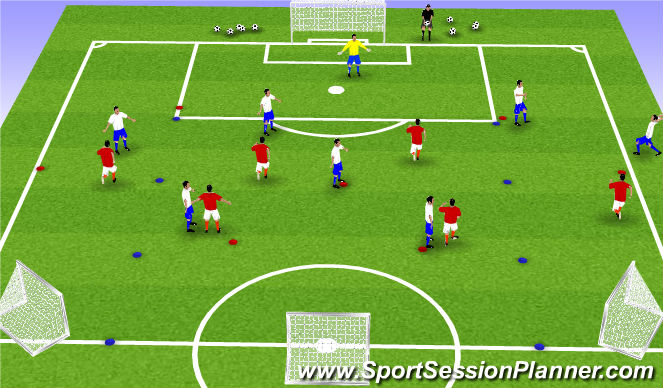
See the guidance at the top of this page to understand why you are not seeing interactive Football/Soccer images.

Throw in progressions (25 mins)
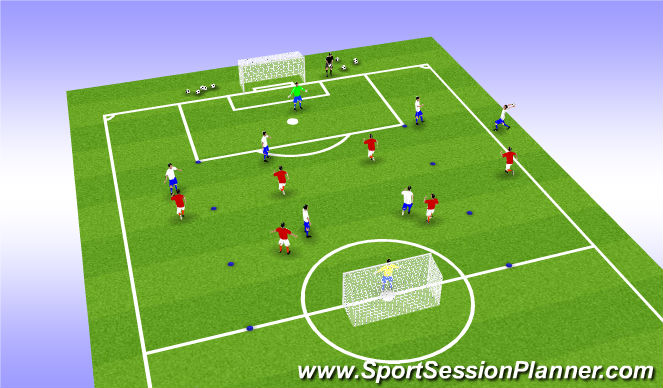
See the guidance at the top of this page to understand why you are not seeing interactive Football/Soccer images.

Screen 6 (25 mins)
Finish with a small sided game with the condition that if the wide areas are used in the build up, goals are worth double. Last 15 minutes let the players have free play with offsides. If possible, do 7v7, have a neutral player (6v6+1) or an overload (e.g. 7v6).
Last 5 minutes if the scores are close challenge the leading team to hold the score and the other team to score or both teams to get a winner if the scores are level. Finish with a penalty shoot out in preparation for a cup match.







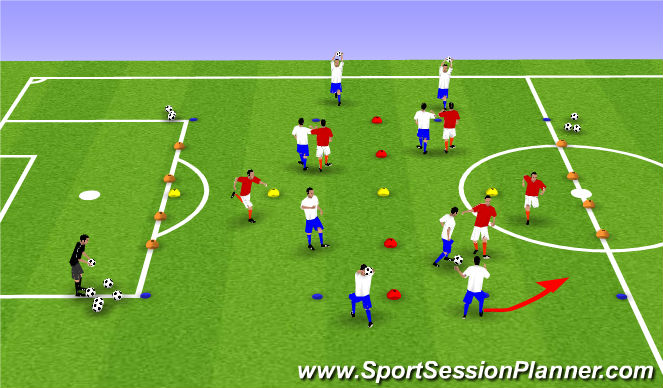
 Play animation
Play animation Play step-by-step
Play step-by-step Repeat (toggle)
Repeat (toggle) Full Screen
Full Screen Pause
Pause Stop
Stop
Arrival activity (15 mins)
In 15 by 20 yards squares, players work in groups of 3 or 4 in a 2v1 or 2v2. Play is started as a server throws the ball to his team mate who may pass the ball back to the thrower as they look to receive, lay off and/ or turn with the ball. The aim is for the receiver or team in possession to travel through the orange gate in their area. If the defender wins the ball, the play restarts.
Coaching points:
- Look to throw to "safe side", away from defender
- Receiver keeps ball away from defender, using appropriate body part to control or return the ball (thigh, head, chest, inside/ outside of foot, laces)
- Body shape; receiver on toes, feet in opposition, knees bent, slight lean forward, back arm up and with slight bend to hold off defender.
- Movement to receive from throw or pass after lay off, supporting at angles.